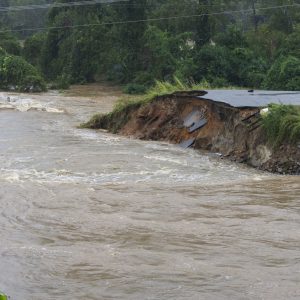South Carolina Floods
When Hurricane Joaquin interacted with a “slow-moving weather system coming across the Southeast,” it resulted in a “1,000 year” rain event and some of the worst flooding South Carolina has ever seen. Flooding was particularly damaging in the area around Columbia, where 17 inches of rain fell on October 4th. Rainfall was so intense that 17 stream gauges placed by the U.S. Geological Survey registered the highest river peak flows that those particular gauges had ever recorded. The President declared it a major disaster area, and dispatched the Federal Emergency Management Agency to begin distributing aid to survivors. 19 total deaths have been reported due to the weather event, many of which occurred when drivers were caught on the roads during flash floods. State officials have likened the event to the catastrophic flooding caused by Hurricane Hugo in 1989.

Damage estimates are still not very clear, but some estimates put the cost close to the $25 billion of damage caused by Hugo. One estimate from CoreLogic, a catastrophe modeling firm, says that home insurers could face costs of around $18 billion. Several roads, including 12 primary routes, remain closed in the state.
The floods were likely made worse by the failure of several dams, especially in the Columbia area, which includes the Gills Creek Watershed. Of the 36 dams that are known to have failed, 23 of them were in the Columbia area. The vast majority of dams in the state are unregulated by the state’s inspection authority with the Department of Health and Environmental Control (DHEC). The estimated 10,000 to 20,000 dams that go uninspected are the responsibility primarily of waterfront associations on small lakes. The major problem here is that individual responsibility within these groups is unclear, and many resist the costs of dam upkeep. Even for dams that are regulated, few resources are made available to maintain an effective inspection regime.
Sources and Further Reading:
- South Carolina in flooding disaster amid record-breaking rainfall and dam breaches – The Washington Post
- South Carolina flood damage could rival Hurricane Hugo – WYFF 4
- CoreLogic: $18B in Potential Losses from South Carolina’s ‘Record-Breaking’ Storm – Insurance Journal
- THE LATEST: Obama declares SC major disaster – The State
- Flood of 2015 was a record-setter in SC – The State
- SCDOT’s Sunday, Oct. 25, Update – South Carolina Department of Transportation
- Thousands of dams avoid state inspections in South Carolina – The Herald
- Lessons Learned from Dam Incidents and Failures – Association of State Dam Safety Officials
- Aging and Underfunded: America’s Dam Safety Problem, In 4 Charts – NPR
- Lakes behind potentially unstable dams being drained – The State
